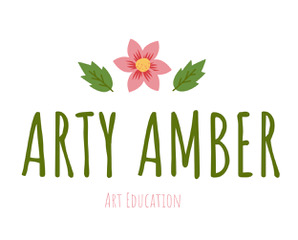Young children flourish in a creative environment where they can bathe in inspiration and their imaginations can run wild. Children are naturally creative, they cant help it – its in their very nature! They love to play, draw, paint and explore all the creative possibilities available.
Amber Foot, from Arty Amber, has given us some brilliant tips to support this.
Creating conditions where the child can flourish without competition, pressure, assessment or exams should be seen as vital to the development of their creative-thinking, problem-solving, fine motor skills, handwriting, self-expression and observational skills. Skills that will journey with them through to adulthood.
But how do we make sure that our children have plenty of creative possibilities to explore? How can we build a creative environment to support their natural development? Lets starts in the home, the child’s first foundations of education…
Tip #1 Where to start
Young children will naturally want to try a range of mediums. This is a great time to expose them to mediums because as they get older they will be less willing to do so and become more aware of the challenges they may encounter. Start by buying a few brilliantly creative basics…
Soft Berol oil pastels and large pieces of paper (A3 or bigger) are a great starting point, or you could buy plain wallpaper and tear off large sheets. Big sheets of paper promote more exploration of the medium as well as the surface, they’ll fill the paper with swirling marks, lines, dots and anything else that comes to mind. Mark-making is a precursor for handwriting, so the more they do the better it is for them to develop those fine motor skills.
An easel or a blackboard is also a great tool as its much easier for young children to stand and draw in an upright position. If you decide to get a blackboard then you will need some chalk pastels. If you’d rather not clean the mess then place a large sheet of paper under the easel to catch the dust.
And finally, you’ll need some pencils. I recommend Fabre Castelle watercolour pencils as you can use them both wet and dry, which exposes your little artist to yet another medium. Try using them dry first and then add water with a wet paintbrush and watch the colours turn to paint – your little one will look on in wonder.
Tip #2 What’s next?
Once you have tried the above and got your creative groove going on, then the next medium I introduce is watercolour paints. You can find these in handy tins so there isn’t a lot of mess. To avoid the colours mixing together and creating that dreaded brown colour, its best to buy 2 tins and then rearrange the colours so that one tin has cold colours (blues, purples and greens) and the other tin has warm colours (yellows, oranges and reds). Give your child 1 of the tins to use and then swap them over half way through the painting. Limiting the pallet in this way is helpful so that your little one doesn’t get overwhelmed with options and gives them space to appreciate each colour group.
Tip #3 Painting top tip
I love to use a method with young children from the age of 3 years old and above. It’s called ‘wet on wet’ painting. Its particularly good with children who are overly concerned with producing technically correct pieces of art as it acts as a type of art therapy. It produces the most beautiful paintings with ease and it is THE BEST way to give your child that creative flair. The paints aren’t easily controlled and so it will also introduce your little artist to the concept of mistakes, which are often seen as failures, but really they are opportunities to make something beautiful. Mistakes have the power to teach us to accept ourselves and the world around us. For the wet on wet method you will need:
– A3 or larger thick paper (minimum 220gsm)
– A bath/large sink/plastic tub with a small amount of water in it (enough to lay your paper flat in to soak)
– Watercolour paints (I recommend Stockmar paints for this, the primary colours are plenty. The colours are vibrant and your little one will love them)
– 3 jars or containers for diluting the Stockmar paints (use a small brush to stir a small amount of paint in a splash of water)
– A tray or cloth to keep the jars of paints on to catch spillages
– A large flat brush size 6 or above
– A waterproof surface such as a plastic sheet, plastic table cloth, large plastic bag (larger than your paper), or a waterproof art board.
The first step is to soak your paper in the water for 15 mins. Take it out and put it on the plastic surface. Give your little one the paint brush and paint jars and patiently encourage them to gently move the paint around the surface. The water will naturally move the paint around the paper and create new colours. They will finish 1 artwork quite quickly so have plenty of paper ready and pre- soaked. Once your mini Picasso has a handle on this painting method try telling them a short story and then ask them to paint something they heard in the story such as a character or an object. They wont be able to paint any real form as the water will blur the edges and the colours will mix together, but that’s the idea – you are teaching them something far more special than how to colour inside the lines!
Tip #4 Should I guide my child in art?
It can be so tempting to join in the creative fun. Watching our little ones drawing or painting fills us with the need to jump in and show them how to draw shapes or letters, guiding them and bringing their awareness to the technical aspects of what they are doing. My best advise is to avoid this, even if you are itching to teach them! Go into another room or distract yourself whilst your little one experiences the glories of painting or drawing. Interfering stops the creative process in its tracks and brings awareness to mistakes, how they could make their painting look better or how it ‘should’ look. The best creative environment for a child to flourish is one where they are left to freely explore the mediums and colours. This will later translate into a love of art, a love of drawing and painting. Then when the time is right they can be introduced to the technical aspects of art, such as drawing shapes, which normally comes at the age of 7 years old and develops into a need to draw and paint realistically by the age of 9 years old.
Tip #5 Going beyond the home
Once you have your basic creative kit built venture outside and start collecting things you find together on your walks such as moss, twigs, acorns, conkers, feathers and pebbles. Your child will love hunting for these objects and then sitting with you to explore the possibilities of what you could do to turn these seemingly simple things into something fun. Grab a glue gun and some acrylic paint pens and make a moss garden with twig people or a twig barn for a pebble animal or a twig raft on a river of feathers. See where your imaginations take you. You don’t have to keep everything you make – return it to the garden or the woods and watch nature reclaim your masterpiece.
Bringing art into the home early on is a wonderful gift to give your child as they will take what they are taught into adulthood. We’re always here to help you achieve these goals through our art clubs, holiday clubs and private tuition.



